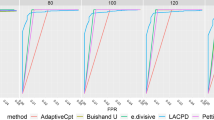Abstract
Change detection within unequally spaced and non-stationary time series is crucial in various applications, such as environmental monitoring and satellite navigation. The jumps upon spectrum and trend (JUST) is developed to detect potential jumps within the trend component of time series segments. JUST can simultaneously estimate the trend and seasonal components of any equally or unequally spaced time series by considering the observational uncertainties or measurement errors. JUST and its modules can also be applied to monitor vegetation time series in near-real-time. Herein, the details of the open-source software package for JUST, developed in both MATLAB and Python, are presented.

Similar content being viewed by others
Abbreviations
- ALLSSA:
-
Anti-leakage least-squares spectral analysis
- CCDC:
-
Continuous change detection and classification
- CWT:
-
Continuous wavelet transform
- DBEST:
-
Detecting breakpoints and estimating segments in trend
- EVI:
-
Enhanced vegetation index
- EWMACD:
-
Exponentially weighted moving average change detection
- GPS:
-
Global Positioning System
- JUST:
-
Jumps upon spectrum and trend
- LSSA:
-
Least-squares spectral analysis
- LSWAVE:
-
Least-squares wavelet
- LSWA:
-
Least-squares wavelet analysis
- NDVI:
-
Normalized difference vegetation index
- OLS:
-
Ordinary least-squares
References
Awty-Carroll K, Bunting P, Hardy A, Bell G (2019) An evaluation and comparison of four dense time series change detection methods using simulated data. Remote Sens 11(23):2779
Brooks EB, Wynne RH, Thomas VA, Blinn CE, Coulston JW (2014) On-the-fly massively multitemporal change detection using statistical quality control charts and Landsat data. IEEE Trans Geosci Remote Sens 52(6):3316–3332
Brooks EB, Yang Z, Thomas VA, Wynne RH (2017) Edyn: dynamic signaling of changes to forests using exponentially weighted moving average charts. Forests 8(9):304
Ghaderpour E (2020) Least-squares wavelet and cross-wavelet analyses of VLBI baseline length and temperature time series: Fortaleza–Hartebeesthoek–Westford–Wettzell. Publ Astron Soc Pac 133(1019):10. https://doi.org/10.1088/1538-3873/abcc4e
Ghaderpour E, Vujadinovic T (2020a) Change detection within remotely-sensed satellite image time series via spectral analysis. Remote Sens 12(23):4001. https://doi.org/10.3390/rs12234001
Ghaderpour E, Vujadinovic T (2020b) The potential of the least-squares spectral and cross-wavelet analyses for near-real-time disturbance detection within unequally spaced satellite image time series. Remote Sens 12(15):2446. https://doi.org/10.3390/rs12152446
Ghaderpour E, Ben Abbes A, Rhif M, Pagiatakis SD, Farah IR (2020) Non-stationary and unequally spaced NDVI time series analyses by the LSWAVE software. Int J Remote Sens 41(6):2374–2390
Ghaderpour E, Pagiatakis SD (2019) LSWAVE: a MATLAB software for the least-squares wavelet and cross-wavelet analyses. GPS Solut 23:50. https://doi.org/10.1007/s10291-019-0841-3
Ghaderpour E, Liao W, Lamoureux MP (2018) Antileakage least-squares spectral analysis for seismic data regularization and random noise attenuation. Geophysics 8(3):V157–V170
Ghaderpour E, Pagiatakis SD (2017) Least-squares wavelet analysis of unequally spaced and non-stationary time series and its applications. Math Geosci 49(7):819–844
Goudarzi MA, Cocard M, Santerre R, Woldai T (2013) GPS interactive time series analysis software. GPS Solut 17:595–603
Hamunyela E, Rosca S, Mirt A, Engle E, Herold M, Gieseke F, Verbesselt J (2020) Implementation of BFASTmonitor algorithm on google earth engine to support large-area and sub-annual change monitoring using earth observation data. Remote Sens 12(18):2953
Jamali S, Jönsson P, Eklundh L, Ardö J, Seaquist J (2015) Detecting changes in vegetation trends using time series segmentation. Remote Sens Environ 156:182–195
Liu HQ, Huete A (1995) A feedback-based modification of the NDVI to minimize canopy background and atmospheric noise. IEEE Trans Geosci Remote Sens 33:457–465
Pagiatakis S (1999) Stochastic significance of peaks in the least-squares spectrum. J Geod 73(2):67–78
Percival DB, Wang M, Overland JE (2004) An introduction to wavelet analysis with applications to vegetation time series. Community Ecol 5:19–30
She X, Zhang L, Cen Y, Wu T, Huang C, Baig MHA (2015) Comparison of the continuity of vegetation indices derived from Landsat 8 OLI and Landsat 7 ETM+ data among different vegetation types. Remote Sens 7(10):13485–13506
Torrence C, Compo GP (1998) A practical guide to wavelet analysis. Bull Am Meteorol 79(1):61–78
Vanìček P (1969) Approximate spectral analysis by least-squares fit. Astrophys Space Sci 4:387–391
Verbesselt J, Hyndman R, Zeileis A, Culvenor D (2010a) Phenological change detection while accounting for abrupt and gradual trends in satellite image time series. Remote Sens Environ 114:2970–2980
Verbesselt J, Hyndman R, Newnham G, Culvenor D (2010b) Detecting trend and seasonal changes in satellite image time series. Remote Sens Environ 114:106–115
Williams SDP (2008) CATS: GPS coordinate time series analysis software. GPS Solut 12(2):147–153
Verbesselt J, Zeileis A, Herold M (2012) Near real-time disturbance detection using satellite image time series. Remote Sens Environ 123:98–108
Zhu Z, Woodcock CE (2014) Continuous change detection and classification of land cover using all available Landsat data. Remote Sens Environ 144:152–171
Zhu Z (2017) Change detection using Landsat time series: a review of frequencies, preprocessing, algorithms, and applications. ISPRS J Photogramm Remote Sens 130:370–384
Author information
Authors and Affiliations
Corresponding author
Additional information
Publisher's Note
Springer Nature remains neutral with regard to jurisdictional claims in published maps and institutional affiliations.
The GPS Tool Box is a column dedicated to highlighting algorithms and source code utilized by GPS engineers and scientists. If you have an interesting program or software package you would like to share with our readers, please pass it along; e-mail it to us at gpstoolbox@ngs.noaa.gov. To comment on any of the source code discussed here, or to download source code, visit our website at http://www.ngs.noaa.gov/gps-toolbox. This column is edited by Stephen Hilla, National Geodetic Survey, NOAA, Silver Spring, Maryland, and Mike Craymer, Geodetic Survey Division, Natural Resources Canada, Ottawa, Ontario, Canada.
Rights and permissions
About this article
Cite this article
Ghaderpour, E. JUST: MATLAB and python software for change detection and time series analysis. GPS Solut 25, 85 (2021). https://doi.org/10.1007/s10291-021-01118-x
Received:
Accepted:
Published:
DOI: https://doi.org/10.1007/s10291-021-01118-x




